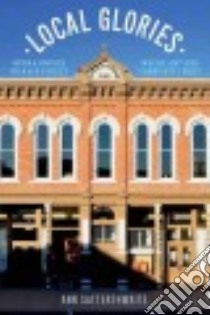- Libreria
- >
- Libri in lingua
- >
- Theatre, drama
Local Glories - 9780199392544
Un libro in lingua di Ann Satterthwaite edito da Oxford University Press, 2016
- € 36.50
- Il prezzo è variabile in funzione del cambio della valuta d’origine
To most people, the term "opera house" conjures up images of mink-coated dowagers accompanied by men in tuxedoes in the gilded interiors of opulent buildings like the Met in New York or Milan's La Scala. However, the opera house in the United States has a far more varied-and far more interesting-history than one might think.
In Local Glories, Ann Satterthwaite explores the creative, social, and communal roles of thousands of "opera houses" that flourished across America. By 1900, opera houses were everywhere: on second floors over hardware stores, in grand independent buildings, in the back rooms of New England town halls, and even in the bowels of a Mississippi department store. With travel made easier by the newly expanded rail lines, Sarah Bernhardt, Mark Twain, and John Philip Sousa entertained thousands of townspeople as did countless actors, theater and opera companies, innumerable minor league magicians, circuses, lecturers, and even 500 troupes solely performing Uncle Tom's Cabin. Often the town's only large space for public assembly, they served as a place for local activities like school graduations, recitations, sports, town meetings, elections, political rallies, and even social dances and roller skating parties. Considered local landmarks, often in distinctive architect-designed buildings, they aroused considerable pride and reinforced town identity.
By considering states with distinctly different histories-including, Maine, Nebraska, Vermont, New York,and Colorado, to name a few-Satterthwaite paints a picture of the diversity of the types of opera houses, programs, audiences, buildings, promoters, and supporters-and their hopes, dreams and ambitions. She extends her discussion to the twentieth century, when radio, movies, and later television and changing tastes made these opera houses seem obsolete. Some were demolished, but those that were abandoned languished for decades until discovered in the last thirty years by stalwart revivers in small towns across the country. The resuscitation of these opera houses today reflects the timeless quest for cultural inspiration and for communal engagement to counter the anonymity of the virtual world. These "local glories" are where art and community meet, forging connections and making communities today, just as they did in the nineteenth century.
Informazioni bibliografiche
- Titolo del Libro in lingua: Local Glories
- Sottotitolo: Opera Houses on Main Street, Where Art and Community Meet
- Lingua: English
- Autore: Ann Satterthwaite
- Editore: Oxford University Press
- Collana: Oxford Univ Pr (Hardcover)
- Data di Pubblicazione: 22 Marzo '16
- Genere: HISTORY
- Pagine: 446
- ISBN-10: 0199392544
- EAN-13: 9780199392544


